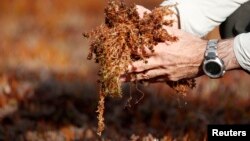SYDNEY —
The carbon-soaking qualities of Australia’s coastal and marine wetlands are the focus of a new international research project. Experts from 20 countries have this week attended a special seminar in Sydney.
Researchers at the University of Technology Sydney say that seagrass, mangroves and saltmarsh capture carbon up to 40 times faster than forests on land.
Marine wetlands are able to store the carbon for very long periods, but scientists worry that these “critical ecosystems” are being destroyed around the world at a rapid rate by development and pollution. It is estimated that this destruction releases as much as 1 billion tons of carbon dioxide each year into the atmosphere and oceans. That is almost the equivalent of Japan’s yearly emissions.
Members of the Blue Carbon International Scientific Working Group, which includes representatives from Indonesia, the United States and Kenya, have been meeting in Sydney to discuss the latest research.
Professor Peter Ralph, the executive director of the Plant Functional Biology and Climate Change Cluster at the University of Technology Sydney, says coastal areas can play an important role in mitigating the effects of climate change.
“An acre of seagrasses is equivalent to 40 acres of terrestrial forest, so these are very small areas. Okay, seagrass, saltmarsh and mangrove represent only 2 per cent of the ocean sea floor, but they bind and hold 50 per cent of the marine ocean’s sediment carbon," Ralph explained. "So it is a very, very small habitat but we need to recognize this and protect it so that we do not lose that carbon back into the atmosphere that has been stored for thousands of years.”
‘Blue carbon’ is the term used to describe the way coastal vegetation such as seagrass, saltmarsh and mangroves store rising levels of atmospheric carbon dioxide, which many scientists blame for warming temperatures.
Professor Ralph says that unlike forests on land, coastal wetlands offer a long-term solution to carbon storage.
“There is no oxygen, so the bacteria break it down really, really slowly, so any carbon we get in the marine environment; in the seagrass, saltmarsh and mangroves is there for thousands and thousands of years. It is locked up. It is out of the atmosphere. It is natural sequestration,” said Ralph.
The International Blue Carbon Initiative is a global program led by Conservation International, the International Union for Conservation of Nature and UNESCO. It brings together governments, research institutions and non-governmental organizations from around the world.
The research is Australia’s most comprehensive study into ‘blue carbon.’ Australia is one of the world’s worst per capita emitters of greenhouse gases, largely because of its reliance on cheap supplies of coal to generate electricity.
Researchers at the University of Technology Sydney say that seagrass, mangroves and saltmarsh capture carbon up to 40 times faster than forests on land.
Marine wetlands are able to store the carbon for very long periods, but scientists worry that these “critical ecosystems” are being destroyed around the world at a rapid rate by development and pollution. It is estimated that this destruction releases as much as 1 billion tons of carbon dioxide each year into the atmosphere and oceans. That is almost the equivalent of Japan’s yearly emissions.
Members of the Blue Carbon International Scientific Working Group, which includes representatives from Indonesia, the United States and Kenya, have been meeting in Sydney to discuss the latest research.
Professor Peter Ralph, the executive director of the Plant Functional Biology and Climate Change Cluster at the University of Technology Sydney, says coastal areas can play an important role in mitigating the effects of climate change.
“An acre of seagrasses is equivalent to 40 acres of terrestrial forest, so these are very small areas. Okay, seagrass, saltmarsh and mangrove represent only 2 per cent of the ocean sea floor, but they bind and hold 50 per cent of the marine ocean’s sediment carbon," Ralph explained. "So it is a very, very small habitat but we need to recognize this and protect it so that we do not lose that carbon back into the atmosphere that has been stored for thousands of years.”
‘Blue carbon’ is the term used to describe the way coastal vegetation such as seagrass, saltmarsh and mangroves store rising levels of atmospheric carbon dioxide, which many scientists blame for warming temperatures.
Professor Ralph says that unlike forests on land, coastal wetlands offer a long-term solution to carbon storage.
“There is no oxygen, so the bacteria break it down really, really slowly, so any carbon we get in the marine environment; in the seagrass, saltmarsh and mangroves is there for thousands and thousands of years. It is locked up. It is out of the atmosphere. It is natural sequestration,” said Ralph.
The International Blue Carbon Initiative is a global program led by Conservation International, the International Union for Conservation of Nature and UNESCO. It brings together governments, research institutions and non-governmental organizations from around the world.
The research is Australia’s most comprehensive study into ‘blue carbon.’ Australia is one of the world’s worst per capita emitters of greenhouse gases, largely because of its reliance on cheap supplies of coal to generate electricity.






